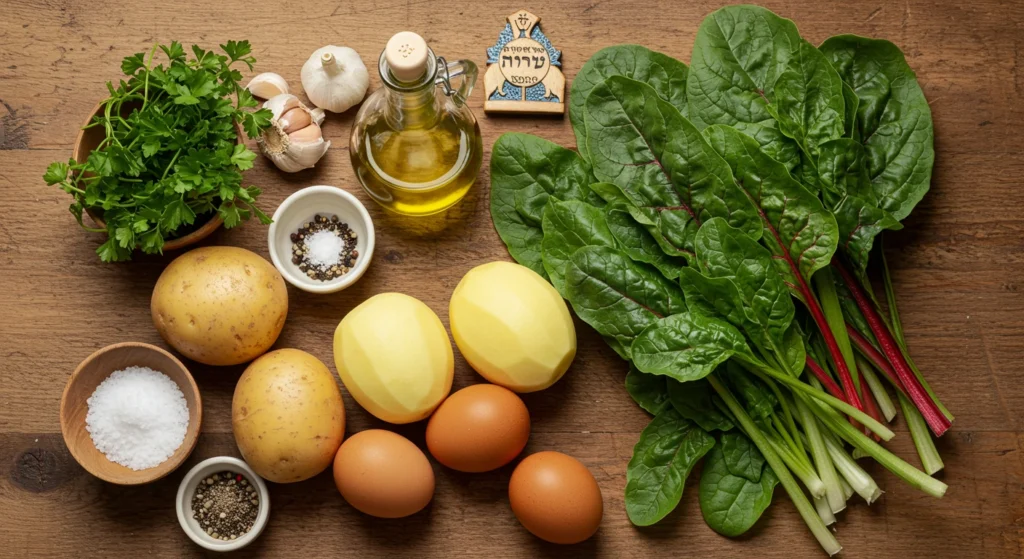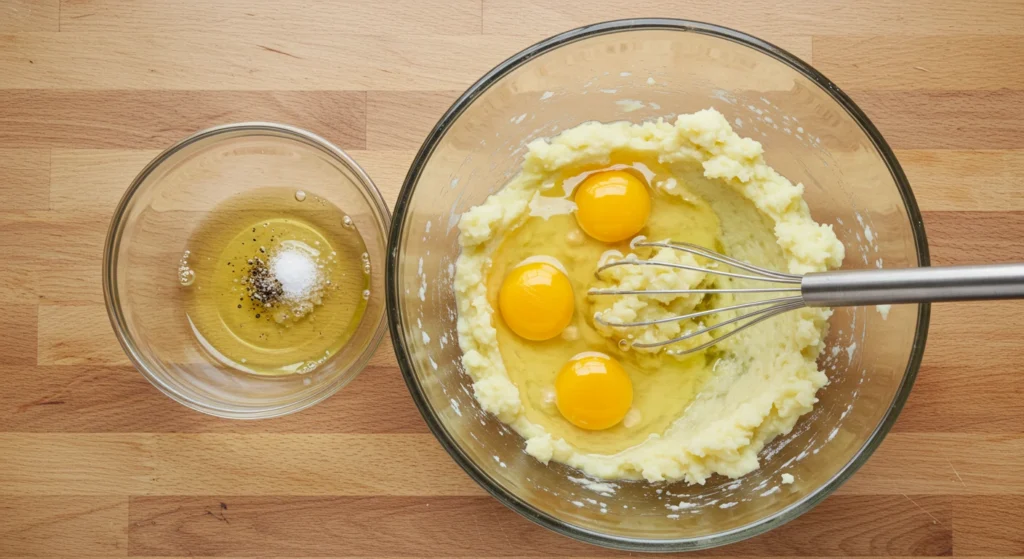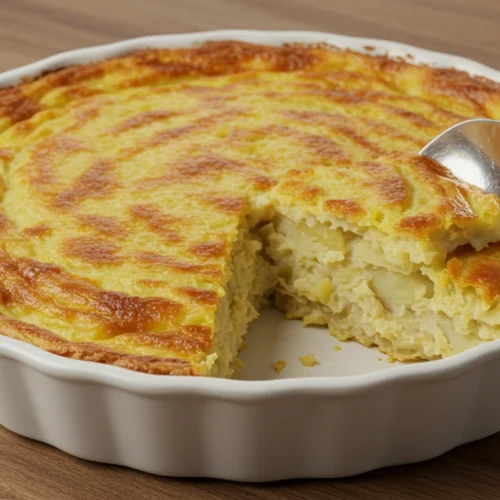Introduction to Passover Potato Pie
What is Passover Potato Pie?
When I think of Passover meals, my mind is immediately filled with vivid memories of my family gathered around the table, the smell of traditional foods wafting through the house. One dish that always stood out during these holiday gatherings was the Passover Potato Pie, a comforting, savory creation that brings together the rich flavors of potatoes and spices in a way that celebrates the essence of the holiday.
Passover Potato Pie is a versatile dish made primarily from potatoes, eggs, and various seasonings. Often enjoyed as a side dish during the Seder meal, it is an excellent example of how simple ingredients can come together to create something truly special. The beauty of Passover Potato Pie lies in its ability to offer both flavor and a sense of tradition. The base of potatoes, eggs, and seasonings is familiar to many Jewish households, but the interpretation of how to prepare it varies from family to family, offering endless possibilities for variations.
Why is Potato Pie Popular During Passover?
The popularity of Passover Potato Pie can be attributed to a number of factors. Firstly, potatoes are a common ingredient that fits within the dietary restrictions of Passover, where leavened bread and certain grains are avoided. Potatoes, with their mild flavor and versatility, serve as the perfect base for a dish that can easily be adapted to meet different tastes. Additionally, the texture and comforting nature of the dish make it an ideal accompaniment to the rich flavors typically found in other Passover dishes, such as brisket or matzo ball soup.
The popularity of this dish during Passover also reflects a desire to stay connected with tradition while embracing the opportunity to innovate and experiment. For many Jewish families, the Passover Seder is a deeply meaningful occasion, and the dishes served during the meal are an important part of that connection. Potato pie offers an accessible, customizable option that fits seamlessly into the broader celebration of Passover, making it a beloved choice year after year.
The History of Passover Potato Pie
Origins of Passover Potato Pie in Jewish Cuisine
The history of Passover Potato Pie can be traced back to Jewish culinary traditions that emphasize simplicity, resourcefulness, and the use of available ingredients during the Passover holiday. Throughout history, Jews living in different regions of the world adapted local ingredients to create dishes that adhered to the rules of the holiday while still providing nourishment and satisfaction.
In Eastern European Jewish communities, potato-based dishes like latkes (potato pancakes) were already a staple in the culinary repertoire. However, during Passover, these dishes took on new forms, as ingredients such as flour and leavening agents were forbidden. The result was the creation of various potato dishes that were both practical and celebratory. Potato kugels and potato pies became particularly popular due to their ability to be made without the inclusion of chametz (leavened bread or grains).
As Jewish people migrated to different parts of the world, including the Middle East and North Africa, they began incorporating local flavors and techniques into their cooking. This led to the development of different variations of potato-based dishes, including the Passover Potato Pie.
The Evolution of Potato-Based Dishes for Passover
Over time, as Jewish communities spread across the globe, the humble potato became an essential component of the Passover meal. In many Sephardic traditions, for example, potatoes were frequently used in dishes such as Maakouda, a traditional Moroccan potato pie that remains a beloved part of the Passover menu in many Sephardic Jewish households.
Potatoes became not only a practical food choice during Passover but also a symbol of the resourcefulness that is central to the holiday’s themes. The ability to turn a simple root vegetable into a delicious and satisfying meal showcases the ingenuity that has been a hallmark of Jewish cuisine throughout history.
Maakouda: A Traditional Moroccan Potato Pie
One of the most iconic variations of the Passover Potato Pie is Maakouda, a Moroccan-style potato pie that is commonly prepared during the holiday. Maakouda is typically made by combining mashed potatoes with a mixture of eggs, olive oil, and spices such as cumin and coriander. This dish is then baked into a golden, crispy pie that offers a delightful combination of textures and flavors.
Maakouda, like other potato-based dishes, highlights the adaptability of the potato in Jewish cuisine. It’s a great example of how local ingredients and spices can be incorporated into a dish to create something truly unique. Whether served as a side dish or a main course, Maakouda has become an integral part of many Jewish families’ Passover celebrations, particularly in Sephardic and North African communities.
Key Ingredients for Passover Potato Pie

Potatoes: The Heart of the Dish
The primary ingredient in Passover Potato Pie is, of course, the potato. Potatoes are a key ingredient in Jewish cuisine, particularly during Passover, as they provide a versatile, filling base that can be flavored in countless ways. Their natural texture lends itself well to the creation of hearty dishes that are both satisfying and comforting.
The choice of potato is important when making Passover 6Potato Pie. Starchy potatoes, such as Russets, work well because they have a higher starch content, which results in a fluffier and lighter texture when mashed. Other varieties, such as Yukon Golds, are also popular due to their creamy texture and slightly buttery flavor.
Eggs, Olive Oil, and Seasonings: The Essential Flavor Components
In addition to the potatoes, eggs play a crucial role in binding the ingredients together and providing structure to the pie. They also contribute to the golden color and rich texture of the dish. Olive oil, a staple in Mediterranean and Middle Eastern cuisines, is commonly used to add moisture and depth of flavor to the pie.
Seasonings such as salt, pepper, garlic, and onion are essential for bringing out the natural flavors of the potatoes. These ingredients can be adjusted according to personal preferences, allowing for a wide range of flavor profiles. For example, adding cumin or coriander gives the dish a more Middle Eastern flair, while incorporating fresh herbs like parsley and thyme can enhance the dish’s brightness.
Greens and Herbs for Extra Flavor: Spinach, Chard, and Dandelion
To further elevate the flavor of Passover Potato Pie, many cooks incorporate leafy greens and fresh herbs into the mix. Greens such as spinach, Swiss chard, or dandelion are commonly added for their earthy flavor and nutritional value. These greens not only enhance the taste of the pie but also provide a burst of color and texture.
Herbs like parsley, cilantro, and dill can be added for a fresh, aromatic note. Depending on the desired flavor profile, some people may choose to include a touch of garlic or onion, while others might prefer to experiment with more exotic spices. The addition of greens and herbs ensures that Passover Potato Pie is not only a comforting dish but also one that is rich in flavor and visual appeal.
Passover Potato Pie vs. Potato Kugel
Understanding the Difference: Potato Pie vs. Potato Kugel
When it comes to Passover potato dishes, two of the most popular options are Passover Potato Pie and Potato Kugel. While these dishes share many similarities, they differ in terms of preparation, texture, and flavor.
Passover Potato Pie is typically made by combining mashed potatoes, eggs, and seasonings, then baking the mixture into a pie crust or directly in a baking dish. The result is a soft and creamy interior with a slightly crispy exterior.
Potato Kugel, on the other hand, is usually made by grating or shredding the potatoes, then mixing them with eggs, onions, and seasonings before baking them in a casserole dish. The texture of potato kugel is often more firm and less creamy than that of a potato pie, with a crispier top and edges.
Similarities Between the Two Dishes
Despite their differences, Passover Potato Pie and Potato Kugel share many similarities. Both dishes highlight the versatility of potatoes and can be easily adapted to suit a variety of tastes. Both also rely on eggs as a key ingredient to provide structure and texture, and both are commonly served during the Passover Seder.
Regional Variations of Potato Dishes for Passover
Across different Jewish communities, there are numerous variations of potato dishes served during Passover. In addition to the more familiar potato pie and potato kugel, variations can include additions like sautéed onions, garlic, or vegetables. Regional differences, such as those found in Ashkenazi or Sephardic traditions, often influence the flavor profile and preparation of these dishes.
How to Make Traditional Passover Potato Pie

Step-by-Step Recipe for Classic Passover Potato Pie
step1:Making Passover Potato Pie is relatively simple, yet the result is a dish that feels special and festive. To start, I peel and boil about 6 large potatoes until they are soft and fully cooked. Once cooked, I mash them with a fork or potato masher until smooth.
step2:In a separate bowl, I whisk together 4 large eggs, about 2 tablespoons of olive oil, and a pinch of salt and pepper. I add this egg mixture to the mashed potatoes, stirring until fully combined. From here, I transfer the mixture to a greased pie dish or a baking pan.
step3:I bake the pie at 350°F (175°C) for 40-45 minutes, or until the top is golden brown and crispy. The result is a warm, comforting potato pie with a smooth, creamy interior and a crisp, flavorful top.
Tips for Perfecting the Texture and Flavor
To achieve the best texture for Passover Potato Pie, it is important to mash the potatoes thoroughly to avoid any lumps. Using starchy potatoes, such as Russets, will give the pie a lighter, fluffier texture. Additionally, incorporating olive oil and eggs ensures that the pie is moist and holds its shape.
Alternative Ingredients for Dietary Restrictions
For those with dietary restrictions, it is easy to make adjustments to the classic recipe. For a dairy-free version, simply swap the eggs for a plant-based egg replacement and use non-dairy olive oil. Those with gluten sensitivities can rest assured that this dish is naturally gluten-free, as long as no flour is added.
Creative Variations of Passover Potato Pie
Adding Greens: Dandelions, Kale, and Spinach
One of the best ways to make Passover Potato Pie even more flavorful is by adding greens like spinach, kale, or dandelion. These greens not only provide an additional layer of flavor but also add nutritional value to the dish. I find that sautéing the greens with a bit of garlic and olive oil before adding them to the potato mixture enhances the flavor.
Flavor Enhancements: Garlic, Onion, and Spices
For an extra burst of flavor, I often add garlic and onion to the potato mixture. These aromatics bring a savory depth to the pie, making it even more satisfying. Spices like cumin, coriander, or paprika can also be added for a more exotic flair, depending on your tastes.
Vegan and Gluten-Free Passover Potato Pie Options
Creating a vegan or gluten-free Passover Potato Pie is simple, as the dish already lends itself to both dietary preferences. Substituting flaxseed or chia seeds for eggs can provide the necessary binding agent, while using gluten-free flour (or none at all) ensures that the dish remains free of gluten.
Serving Passover Potato Pie
Best Ways to Serve Passover Potato Pie
Passover Potato Pie can be served as a side dish to complement a variety of main courses, from brisket to roasted vegetables. I’ve found that cutting the pie into wedges makes it easy to serve to a crowd, and it pairs wonderfully with a light salad or a refreshing bowl of fruit.
Pairing Passover Potato Pie with Traditional Seder Foods
At the Passover Seder, Potato Pie pairs well with traditional dishes such as matzo ball soup, roasted chicken, and charoset. The creamy texture of the pie offers a nice contrast to the more robust flavors of these other dishes.
Serving Suggestions for Family Meals and Gatherings
For family meals and gatherings, I recommend serving Passover Potato Pie in larger portions, as it tends to be a crowd-pleaser. It can be made ahead of time and reheated before serving, making it a convenient option for busy holiday preparations.
Nutritional Information and Health Benefits of Passover Potato Pie
Calories and Macronutrients in Passover Potato Pie
Passover Potato Pie is a rich dish that provides a good amount of calories, primarily from potatoes and eggs. A single serving can contain roughly 200-300 calories, depending on the specific recipe and portion size.
Health Benefits of Using Potatoes and Greens
Potatoes are an excellent source of potassium, vitamin C, and fiber. When combined with leafy greens such as spinach or kale, the dish becomes even more nutrient-dense, offering additional vitamins and minerals.
Tips for a Healthier Passover Potato Pie
To make Passover Potato Pie healthier, consider using less oil or choosing healthier oil options such as avocado oil. Adding more greens to the dish can boost its fiber content, while using egg substitutes can reduce the calorie count.
FAQs About Passover Potato Pie
What is Potato Kugel Made Of?
Potato kugel is typically made by grating potatoes and mixing them with eggs, onions, and seasonings before baking. The dish has a firmer texture than Passover Potato Pie and is often served as a casserole.
Can Jews Eat Potatoes on Passover?
Yes, potatoes are a common food during Passover, as they do not contain chametz and are therefore permissible to eat during the holiday.
Can You Eat Potato Kugel on Passover?
Yes, potato kugel is a popular Passover dish, as it adheres to the dietary restrictions of the holiday.
What is the History of Maakouda?
Maakouda is a traditional Moroccan potato pie that has been enjoyed by Sephardic Jewish communities for generations. The dish is typically made with mashed potatoes, eggs, and spices, offering a savory, flavorful option for Passover meals.
What is Potato Kugel Made Of?
Potato kugel is typically made by grating potatoes and mixing them with eggs, onions, and seasonings before baking. The dish has a firmer texture than Passover Potato Pie and is often served as a casserole.
Can Jews Eat Potatoes on Passover?
Yes, potatoes are a common food during Passover, as they do not contain chametz and are therefore permissible to eat during the holiday.
Can You Eat Potato Kugel on Passover?
Yes, potato kugel is a popular Passover dish, as it adheres to the dietary restrictions of the holiday.
What is the History of Maakouda?
Maakouda is a traditional Moroccan potato pie that has been enjoyed by Sephardic Jewish communities for generations. The dish is typically made with mashed potatoes, eggs, and spices, offering a savory, flavorful option for Passover meals.
_______________________________________

passover potato pie
Ingredients
Potatoes: The Heart of the Dish
- The primary ingredient in Passover Potato Pie is of course, the potato. Potatoes are a key ingredient in Jewish cuisine, particularly during Passover, as they provide a versatile, filling base that can be flavored in countless ways. Their natural texture lends itself well to the creation of hearty dishes that are both satisfying and comforting.
- The choice of potato is important when making Passover 6Potato Pie. Starchy potatoes such as Russets, work well because they have a higher starch content, which results in a fluffier and lighter texture when mashed. Other varieties, such as Yukon Golds, are also popular due to their creamy texture and slightly buttery flavor.
Eggs, Olive Oil, and Seasonings: The Essential Flavor Components
- In addition to the potatoes eggs play a crucial role in binding the ingredients together and providing structure to the pie. They also contribute to the golden color and rich texture of the dish. Olive oil, a staple in Mediterranean and Middle Eastern cuisines, is commonly used to add moisture and depth of flavor to the pie.
- Seasonings such as salt pepper, garlic, and onion are essential for bringing out the natural flavors of the potatoes. These ingredients can be adjusted according to personal preferences, allowing for a wide range of flavor profiles. For example, adding cumin or coriander gives the dish a more Middle Eastern flair, while incorporating fresh herbs like parsley and thyme can enhance the dish’s brightness.
Greens and Herbs for Extra Flavor: Spinach, Chard, and Dandelion
- To further elevate the flavor of Passover Potato Pie many cooks incorporate leafy greens and fresh herbs into the mix. Greens such as spinach, Swiss chard, or dandelion are commonly added for their earthy flavor and nutritional value. These greens not only enhance the taste of the pie but also provide a burst of color and texture.
- Herbs like parsley cilantro, and dill can be added for a fresh, aromatic note. Depending on the desired flavor profile, some people may choose to include a touch of garlic or onion, while others might prefer to experiment with more exotic spices. The addition of greens and herbs ensures that Passover Potato Pie is not only a comforting dish but also one that is rich in flavor and visual appeal.
Instructions
step1:Making Passover Potato Pie is relatively simple, yet the result is a dish that feels special and festive. To start, I peel and boil about 6 large potatoes until they are soft and fully cooked. Once cooked, I mash them with a fork or potato masher until smooth.
step2:In a separate bowl, I whisk together 4 large eggs, about 2 tablespoons of olive oil, and a pinch of salt and pepper. I add this egg mixture to the mashed potatoes, stirring until fully combined. From here, I transfer the mixture to a greased pie dish or a baking pan.
step3:I bake the pie at 350°F (175°C) for 40-45 minutes, or until the top is golden brown and crispy. The result is a warm, comforting potato pie with a smooth, creamy interior and a crisp, flavorful top.
Tips for Perfecting the Texture and Flavor
- To achieve the best texture for Passover Potato Pie, it is important to mash the potatoes thoroughly to avoid any lumps. Using starchy potatoes, such as Russets, will give the pie a lighter, fluffier texture. Additionally, incorporating olive oil and eggs ensures that the pie is moist and holds its shape.
Notes
Nutrition Information (Per Serving):
- Calories: 250 kcal
- Fat: 10g
- Saturated Fat: 1.5g
- Unsaturated Fat: 8.5g
- Protein: 6g
- Carbohydrates: 35g
- Dietary Fiber: 4g
- Sugars: 2g
- Sodium: 240mg
- Cholesterol: 70mg
- Potassium: 500mg
- Vitamin A: 6% of daily value
- Vitamin C: 15% of daily value
- Calcium: 4% of daily value
Conclusion: Why Passover Potato Pie is a Must-Have Dish for the Holiday
The Appeal of Passover Potato Pie for Jewish Families
For Jewish families, Passover Potato Pie offers a delicious way to honor tradition while also bringing a sense of creativity to the holiday meal. The dish is comforting, versatile, and adaptable to a wide range of tastes and dietary preferences.
How This Dish Bridges Tradition and Innovation
Passover Potato Pie exemplifies how Jewish cuisine can evolve while maintaining its connection to tradition. Whether served in its classic form or with creative variations, this dish continues to be an important part of many families’ Seder tables.
A Final Word on Enjoying Potato Pie During Passover
Passover Potato Pie is more than just a dish; it is a celebration of family, tradition, and the joy of sharing a meal together. No matter how you prepare it, this dish is sure to be a beloved part of your Passover celebrations for years to come.

